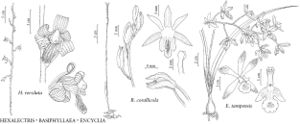Encyclia
Bot. Mag. 55: plate 2831. 1828.
| Taxon | Illustrator ⠉ | |
|---|---|---|
 | Hexalectris revoluta Basiphyllaea corallicola Encyclia tampensis | Barbara Alongi Barbara Alongi Barbara Alongi |
Herbs, epiphytic. Roots fleshy, glabrous. Stems aggregate, erect, forming ovoid-pyriform pseudobulbs. Leaves apical, sessile, articulate; blade linear-elliptic, leathery. Inflorescences apical, racemes to panicles, flowering only once; spathe absent. Flowers resupinate, pedicellate, simultaneous; sepals subequal; petals similar; lip appressed to column, adnate only at base, callus boatshaped; pollinia 4, obovoid, laterally compressed, subequal; caudicles 4 in 2 pairs; column winged; rostellum semiorbiculate, entire, abaxially covered with viscous substance. Fruits capsules, ellipsoid, 3-ribbed, 1-locular.
Discussion
Species over 750 (1 in the flora).
Stems of the encyclias are variable outside the flora area: rarely they are canelike and do not form pseudobulbs; leaves are sometimes semiterete. The genus has been misrepresented as epidendrums having pseudobulbs (O. Ames et al. 1936), as most of them do; some epidendrums also do.
The Florida species were segregated by J. K. Small (1933) into four genera: Encyclia, Hormidium, Anacheilium, and Epicladium. Most later authors recognized only Epidendrum or Epidendrum and Encyclia. Recent attempts for the reestablishment of Anacheilium and Hormidium (G. F. Pabst et al. 1981; R. P. Sauleda et al. 1984) were based mainly on Brazilian species and did not take Mexican species into consideration. Prosthechea has been recently recognized (W. E. Higgins 1997[1998]), thus leaving only one species of Encyclia in the flora area.
Encyclia rufa (Lindley) Britton & Millspaugh has been excluded from the flora because only one specimen has been recorded, and it was probably introduced (R. P. Sauleda 1983). The species is endemic to the Bahamas and Cuba.
Selected References
None.